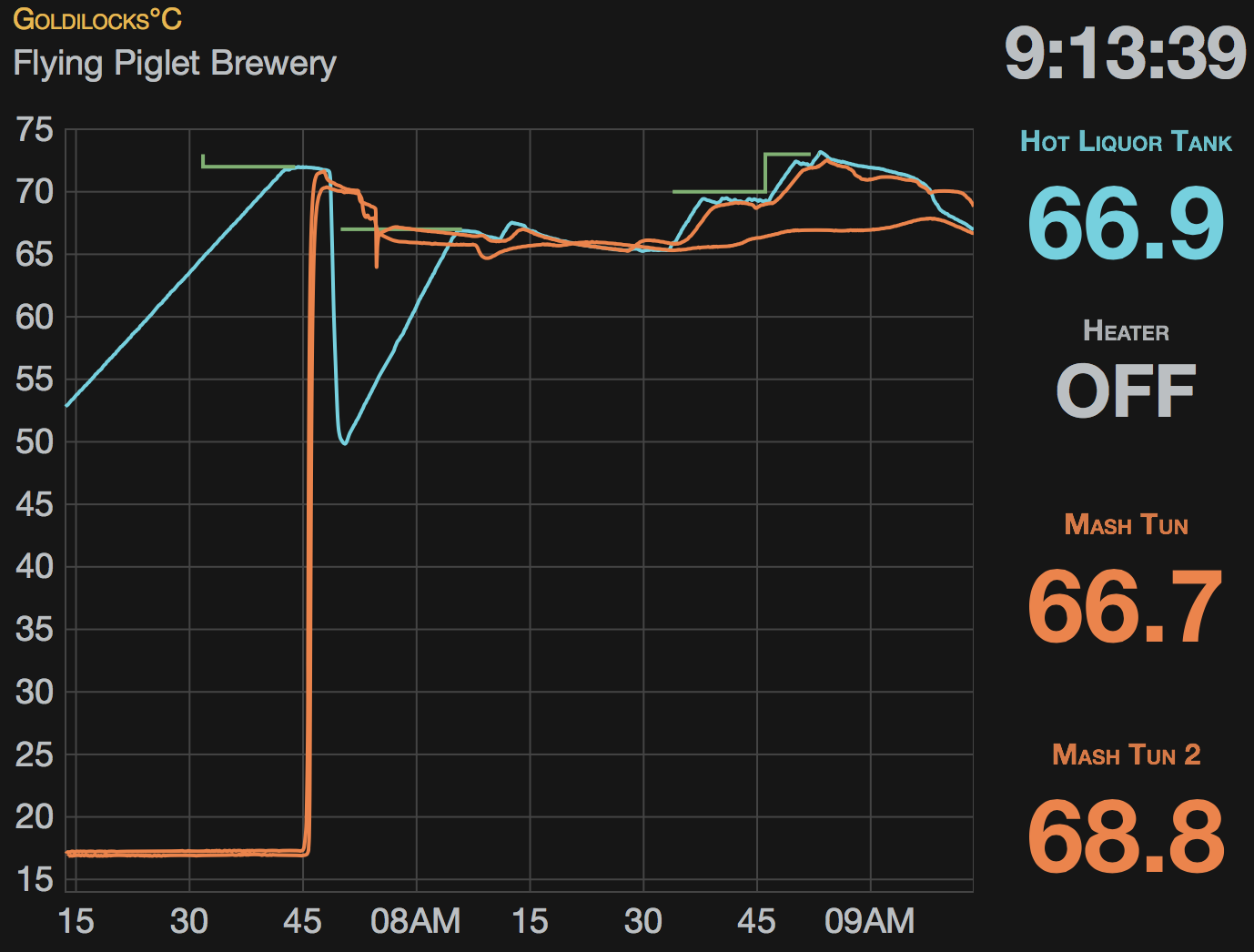Raspberry Pi based temperature logging and/or control software for home brewing. Reads 1-wire DS18B20 temperature probes and optionally enables/disables heating element(s) using output pin(s). The user interface is web based and mobile-friendly so you can monitor and control your brewing over Wifi using a phone or tablet. The temperature control algorithm automatically tunes itself.
I am using Raspbian installed via NOOBS on my Pi but Goldilocks should run on anything with Java 8 installed. For Debian based systems (e.g. Raspbian) try the following instructions.
First install Pi4j. This is very simple:
$ curl -s get.pi4j.com | sudo bash
If you aren't happy running a random script from the internet on your Pi or have issues please refer to the Pi4j site. Now download and install Goldilocks:
$ sudo bash
# wget https://github.com/davidtinker/goldilocks/releases/download/v1.0.0-beta/goldilocks-1.0.0.deb
# dpkg -i goldilocks-1.0.0.deb
Browse to http://10.0.0.103:5050/ (replace 10.0.0.103 with the IP address of your Pi) and you should see the Goldilocks UI. It might take a little while to come up.
Uninstall goldilocks and then re-install use a newer .deb file:
$ sudo bash
# dpkg -r goldilocks
Goldilocks is known to work with the following hardware:
- Raspberry Pi Model B tiny Linux computer
- DS18B20 1-wire temperature probes
- A heating element attached to one of the output pins of the Pi, via a solid state relay
There are lots of guides online on how to get these working:
Click "Goldilocks" on the title bar to set the name of your brewery and change to Fahrenheit if you don't like metric. Click the chart area to open the "Chart Settings" dialog, then click the "Add Control" button. Click "Configure Control" to open the "Control Settings" dialog.
Each control has a name, optional temp probe, optional output pin and a color. Controls with only a temp probe configured just log temperature (e.g. a mash tun). Controls with a temp probe and output pin configured can be set to automatically raise the temperature until a target temp is reached (e.g. a hot liquor tank with electric heating element). Controls can also have just an output pin (e.g. for turning a pump on/off).
The temperature probes listed in the drop down are discovered by listing /sys/bus/w1/devices. If the drop down is empty then likely your probe(s) are not being picked up by the Pi (check your wiring etc.).
You can re-configure controls by clicking the name next to the chart. If the control has an output then click the "OFF/ON" label to turn the output on or off and to enter a target temperature for automatic temperature control.
This is a piece of software and will definitely have bugs. Use this software at your own risk. Controlling heating elements with software is a dangerous business. Some safety hints:
- Don't leave your heater element connected to your solid state relay if there isn't water in your HLT
- Don't leave your brewery alone while the water in the HLT is heating up
- Don't leave your brewery alone if your heater element is connected to the system
The server side of the application is written in Groovy and Java 8 using the Ratpack web framework. The client side is a single-page Javascript application using Node.js, Browserify, ReactJS with Flux. This was my first ReactJS application and I am planning on rewriting the client using ReactJS with other better tools.
You need to install Node. Then do:
$ cd src/ratpack/public
$ npm install
$ npm start
This will install all the Goldilocks dependencies and start a script that buildles the application into a single js file. When .js or .jsx files change the application is automatically rebuilt. There is no live reloading however so you still need to reload the page in your browser.
The server is built using Gradle and you need version 2.3 or newer. You also need Java 8. To run the server locally create /var/lib/goldilocks and give your user write access. Then do:
$ gradle run
This starts the server with the -DfakePi=true switch for development on your Mac or Linux machine. The 'fake' Pi has a couple of temperature probes attached and the heater pin is GPIO_17. Browse to http://127.0.0.1:5050/ to see it in action.
You can build a fat jar and run that directly:
$ gradle shadowJar
$ java -DfakePi=true -jar build/libs/goldilocks-*.jar
To build the .dev package:
$ gradle deb
GNU General Public License (GPL) version 3.0
